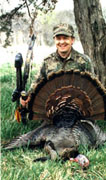Myths About Turkeys
Copyright © 1998 -
2024
Roger W. Raisch * Nadine Adele, all rights reserved
|
The wild turkey is
one of our most spectacular game birds, especially the impressive adult male gobbler. They are certainly one of the most difficult to hunt based on the
fact that probably no more than 30% of hunters nationwide bag a bird each year.
Myths and legends have developed over generations of turkey hunters to explain why we're
consistently outwitted by a bird. Many turkey hunters
are so in awe of wild turkeys that they've created the image of a SUPERBIRD!
|
A bird that is smarter
than any normal human, especially smarter than us hunters!? I've heard and read
so-called experts say that a turkey:
|
Has X-Ray like vision
Can hear 10 times better
than a man
Can detect the smallest
error in your calling
Is so smart that if you call
him in and don't bag him, no one will ever be able to call him in again
- I even had one of my seminar students tell
me that he thought a turkey could hear the ticking of a watch at 20 yards!
-
|
None of those
previous comments about turkeys are true....they are all Myths. If you believe these type of old wives' tales, your development as
a turkey hunter will not advance far. Yes, turkeys have keen senses for survival
that have been honed over centuries. But, they are not intelligent in human
terms. They can't think well independently. They do learn to a degree from
past experiences. For example, they know the frightening shape of a human and that
it means danger. But, I've bagged gobblers that had shot in them from prior
experiences with man. They didn't learn much. I
think humans have mistakenly identified the wild turkey's tremendous capabilities for
survival as intelligence. If it wasn't for the strong
mating instincts of gobblers in the spring, almost nobody would tag one, because at other
times of the year, it's hard to even lay an eye on a tom because they are so quiet and
secretive.
|
Turkeys aren't SUPERBIRDS and can be routinely bagged by
those willing to learn as much as possible about the bird's Physical Senses and Abilities, their Spring Behavior, and their Fall Behavior. |
|
| |
t

God Bless America
|
View
Cart & Check-Out
JANUARY
2026
877.267.3877
515.299.5388
24 / 7
WE answer
our
phones Personally!
|
|












